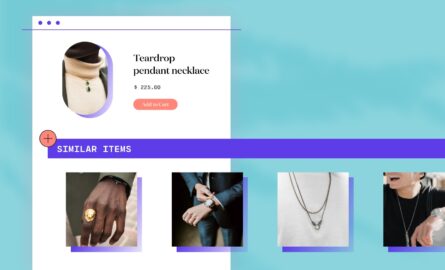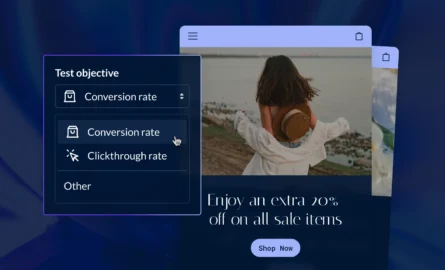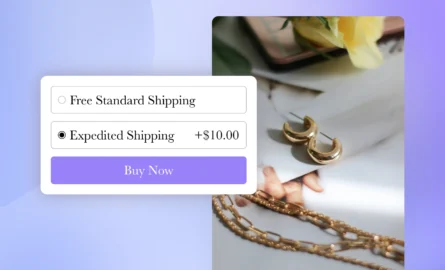How to Run a Successful Pop-Up Shop That’ll Stand Out in 2023
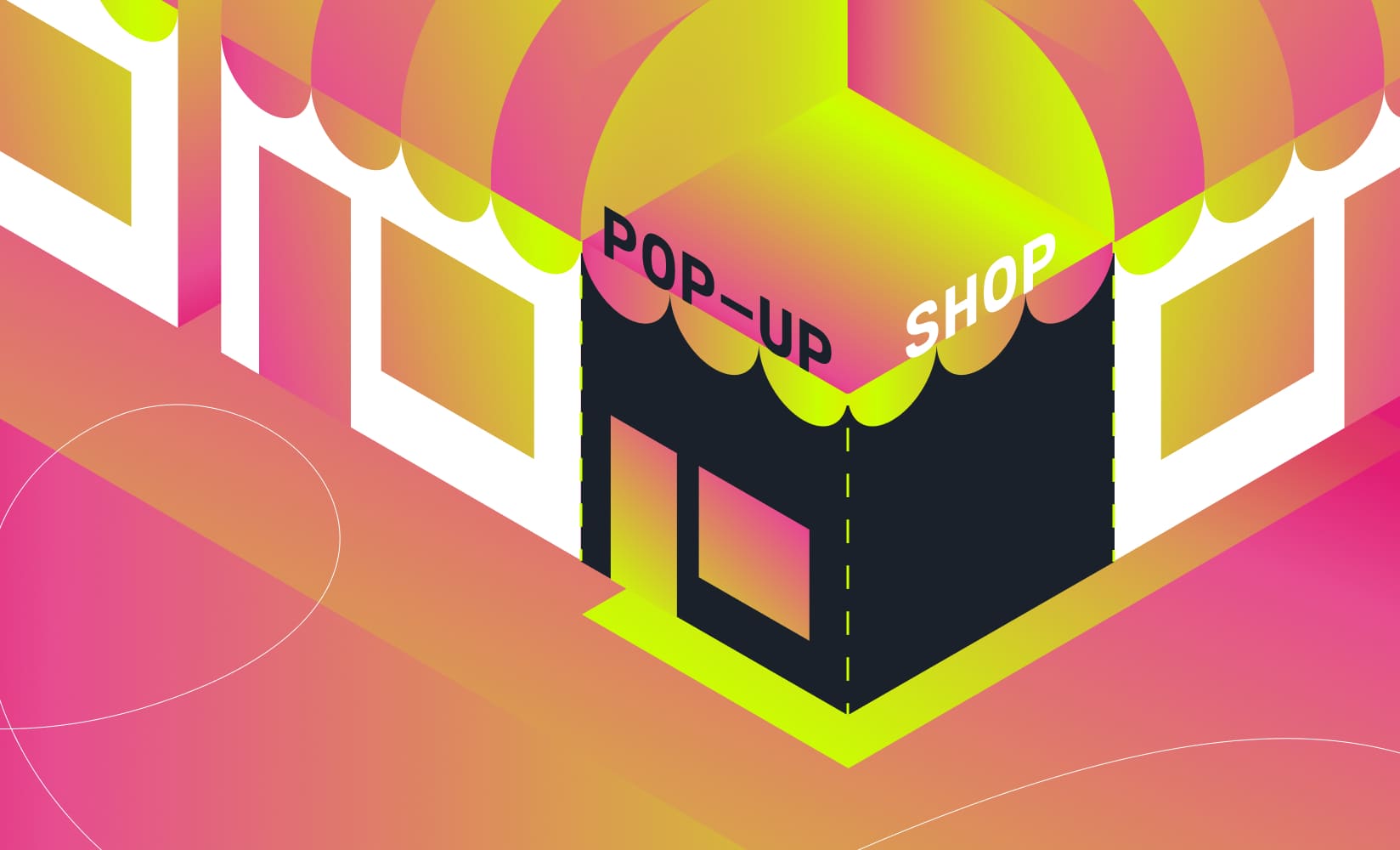
Scaling multi-channel brands are always looking for ways to create the best possible experience for customers—both online and offline. A big part of this involves building hype.
In digital, this is done through rich, engaging shopping experiences (think: Daring, or TULA Skincare). In real life, it’s through experiential retail like pop-up shops.
Pop-up shops are an excellent way to generate brand awareness and bridge the brand experience gap between online and in-person. If you’ve been thinking about running your own pop-up shop but aren’t sure where to start, you’ve come to the right place.
Today, we’re covering:
- What is a pop-up shop?
- The brand experience benefits of running a pop-up shop
- How to plan successful execution
- How to choose the perfect location for a pop-up store
- How to advertise your pop-up shop
- How to measure the ROI of a pop-up experience
- Examples of awesome pop-ups in the wild
Let’s get started!
A pop-up shop is a temporary space brands use to create engaging in-person shopping experiences. The fleeting nature of pop-up stores makes them feel exclusive and time-sensitive, which has great benefits.
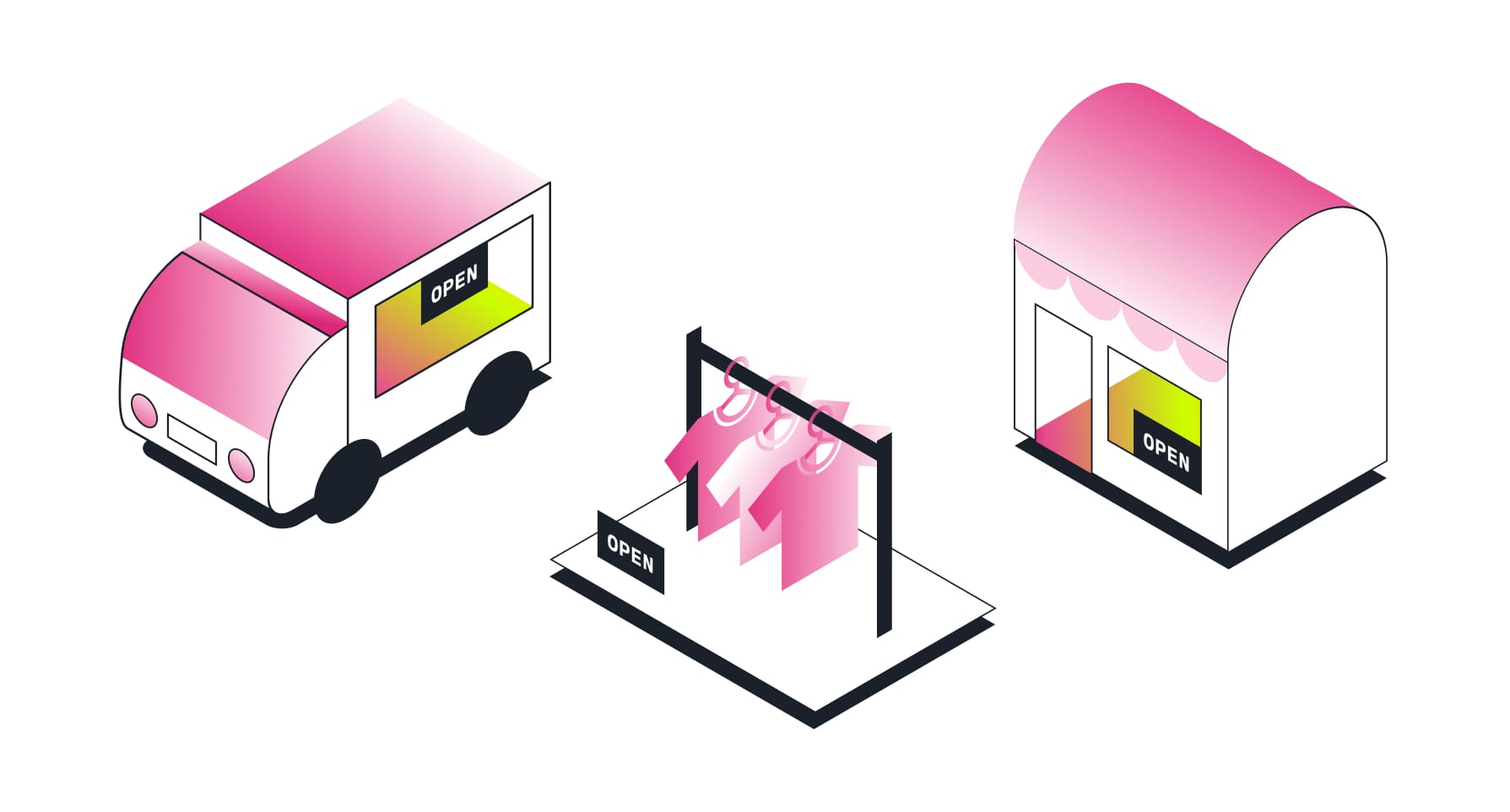
Pop-up shops are used by both online-first and brick-and-mortar brands to engage with local communities, meet customers IRL, and drum up excitement.
As the use of retail space continues to evolve, brands are finding interesting ways to take over temporary spaces—from luxury labels like Dolce & Gabbana’s mobile pop-up in the Hamptons to pet accessories company BarkBox’s Barkshop.
With the pop-up shop market valued at $14B in the US, brands looking to create unique physical retail experiences for customers needn’t look any further.
Owning your online experience is crucial for brand differentiation, but making your foray into the pop-up shop game has several benefits too. Let’s go over a few of the biggest.
1. Create excitement around your brand
There are endless ways to position a pop-up shop to create buzz and brand awareness. Live music, product demos, and speaker sessions are just a few unique ways brands are drumming up excitement for their pop-up shop.
Plus, you can dial up (or down) the level of exclusivity depending on your goals.
Want to promote a new product launch? Make your pop-up shop open to the public. Want to show your loyal customers how much you value them? Host a VIP, invite-only pop-up where your biggest fans can get an early look at new products.
Either way, you can get intentional about locations or regions where you have an existing community, or want to engage a new one.
2. Connect with customers IRL
Pop-ups are the perfect opportunity to meet customers in person. This is especially true for DTC or online-first brands without physical retail outlets.
Pop-up shops allow you to meet some of your biggest brand fans and keep customer evangelism strong. It’s also a great way to boost conversions.
A great example is DTC mattress brand, Leesa.

Leesa partnered with ArtLifting, an online art marketplace for homeless, disabled, and other disadvantaged artists to launch “The Leesa Dream Gallery” in SoHo, NYC. Customers could test out Leesa mattresses in person and discover new artists in a relaxed environment.
The Leesa Dream Gallery is an excellent example of how DTC brands can use temporary physical retail to connect with their local community in a meaningful way.
#cta-visual-pb#<cta-title>Build optimized store pages, fast—without code<cta-title>Get more conversions with a no-code page builder your whole team can use. Learn more
3. Drive more sales
Pop-up shops are great for fast-growing brands looking to expand into other channels. Adding physical retail into the mix means another customer touchpoint, which can bump up revenue.
Many brands host pop-up shops during busy seasons leading up to Black Friday and beyond. But they’re not just great during busy times—they can turn casual shoppers into lifelong customers who return to shop online (or visit your next pop-up!).
4. Move older product
Older inventory doesn’t just take up space on your shelves, it also impacts your bottom line. At the end of 2020, US retailers were holding $1.33 of inventory for every $1 in sales 😬
Pop-up shops offer another channel to breathe new life into old products. Use visual merchandising techniques to create unique displays, or bundle products together.
5. Explore permanent retail possibilities
For brands with online-only presences, expanding into retail might seem like choppy waters. Pop-up shops let you see if long-term retail space could be a viable channel for your brand.
If your pop-up shops are repeatedly successful—driving foot traffic, boosting revenue, and creating more lifelong customers—it could be worth looking into something more permanent.
Even though pop-up shops are temporary, that doesn’t mean there’s less work to launch one—and have it be a hit!
Let’s look at the key components your team should consider.
Defining your goals
To foster pop-up shop ideas and gauge success for your brand, it helps to have set goals. Plus, when you go to measure the ROI of your pop-up shop, it’ll be easier to determine how things went and what can be improved for next time.
Here are a few questions to think about:
- Why do you want to run a pop-up shop? Do you want to promote a new product? Connect with customers offline in a specific location? Determining the “why” can inform other aspects of planning.
- What will your brand and customers gain? Think about what’s to be gained on both sides of the aisle—for your brand it could be awareness and an uptick in sales, and for your customers it could be connecting with a favorite brand and discovering new products.
- What will entice customers to visit? How you market your pop-up will determine success. Consider an interesting angle to encourage foot traffic—like how customers received an exclusive Levi’s tote with purchase at a Levi’s and Stencil1 pop-up shop.
Designing your pop-up shop
With a temporary space, you get the chance to get creative with your in-store atmosphere and experience. Whether you want to do something experimental, as architecture firm Snarkitecture did for COS Los Angeles:
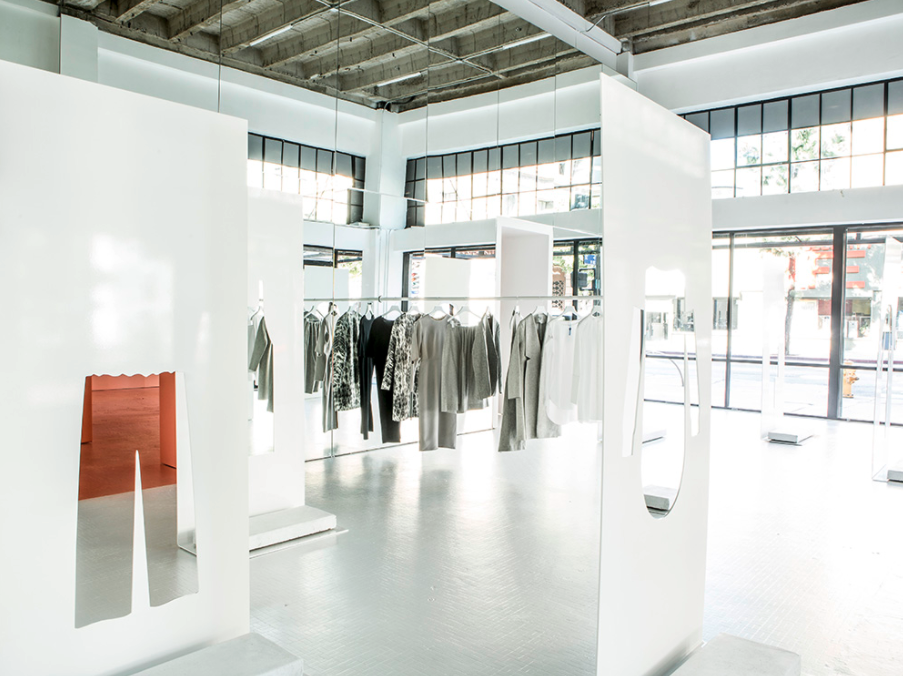

Or something that more closely resembles a traditional brick-and-mortar shopping experience, like the 96 Hours in Abercrombie pop-up shop:
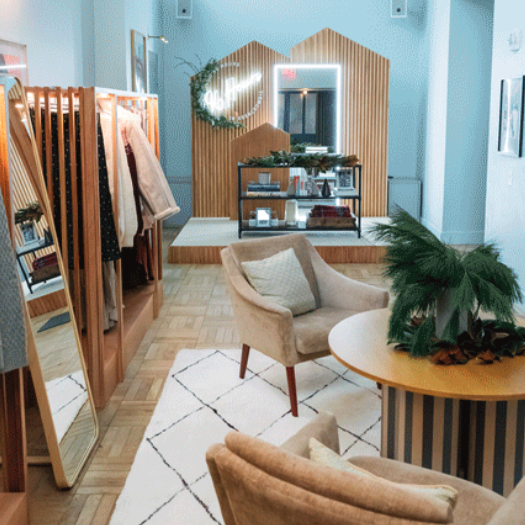
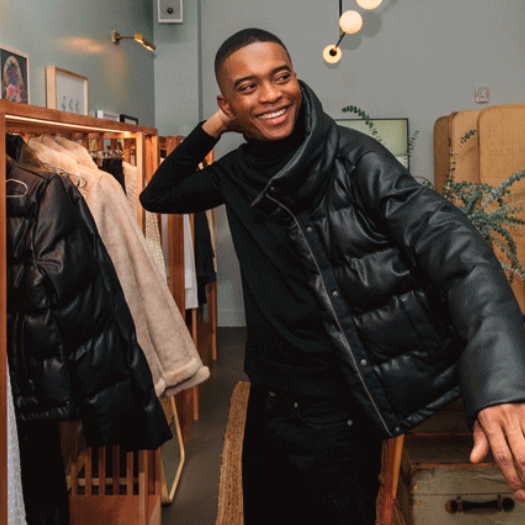
Creativity knows no limits with pop-up shops!
Define the vibe of your shopping experience by asking:
- How do you want customers to feel when they step into your pop-up shop?
- What should they do once they’re there?
- What should customers take away from the experience?
The atmosphere should align with your goals. For example, if you want to build buzz about your brand, something experimental might be best. But if your goal is to sell more products, something that feels more like traditional shopping is a great route.
Pop-up stores are appealing to growing brands for many reasons, but a big one being they offer the chance to experiment with your in-store shopping experience. The venue (or vehicle!) you choose is a big part of this.
Here’s a list of the most popular pop-up venues:
- Empty retail space: The tried and true space is none other than an empty brick-and-mortar store. Because this closely resembles a permanent retail space, this venue is likely to have most (if not everything) you’ll need to get your pop-up poppin’.
- Pop-ins: Pop-ins are simply pop-up shops within a larger retail store, like when LA bakery Four & Twenty Blackbirds held a pop-up inside a Jeni’s Splendid Ice Cream store with—you guessed it—exclusive pie flavors.
- Gallery/art event space: This venue type is great for getting a little futuristic. Gallery spaces are teeming with potential. What better place to bring your creative vision to life than in an art space?
- Truck or van: Don’t want to wait for foot traffic? Want to be about town? Choosing a vehicle for your pop-up shop venue is a great choice. Not only do you have location flexibility—why not host your pop-up by the beach or on a mountainside like sustainable clothing brand Paka Apparel?—but it adds a level of excitement.
Not sure which venue to choose? Tools like The Storefront, Appear Hear, and Peerspace can help you browse available spaces within your price range (more on cost later).
Questions to ask before committing to a pop-up space
Before going all-in on a space, make sure you have answers to the following questions.
- Is this within your budget? The space will be a large portion of your budget. Just make sure it doesn’t eat the entire thing!
- What is included? Any hidden costs you should be aware of? Make sure you know exactly what you’re getting before booking. If the space doesn’t have everything you need, make sure you can afford those extra costs.
- What are the specs? Book a space large enough for the experience you envision.
- How much creative free reign do you have? Can you modify the space? If you plan to build anything, make sure that’s doable.
- Is the location prime for foot traffic? Hosting a pop-up in a prime, people-heavy location guarantees additional foot traffic from customers you might not have reached with your marketing efforts.
- Will you need insurance? Who’s liable? Understanding what you’re responsible for—like if a fire happens or the space is broken into—is super important before signing on the dotted line.
- What is the Wifi setup? POS? You’ll need an internet connection to run your pop-up, so make sure you know if it’s included in the space or if you’ll need to bring your own.
Here’s a handy checklist to refer back to as you plan:
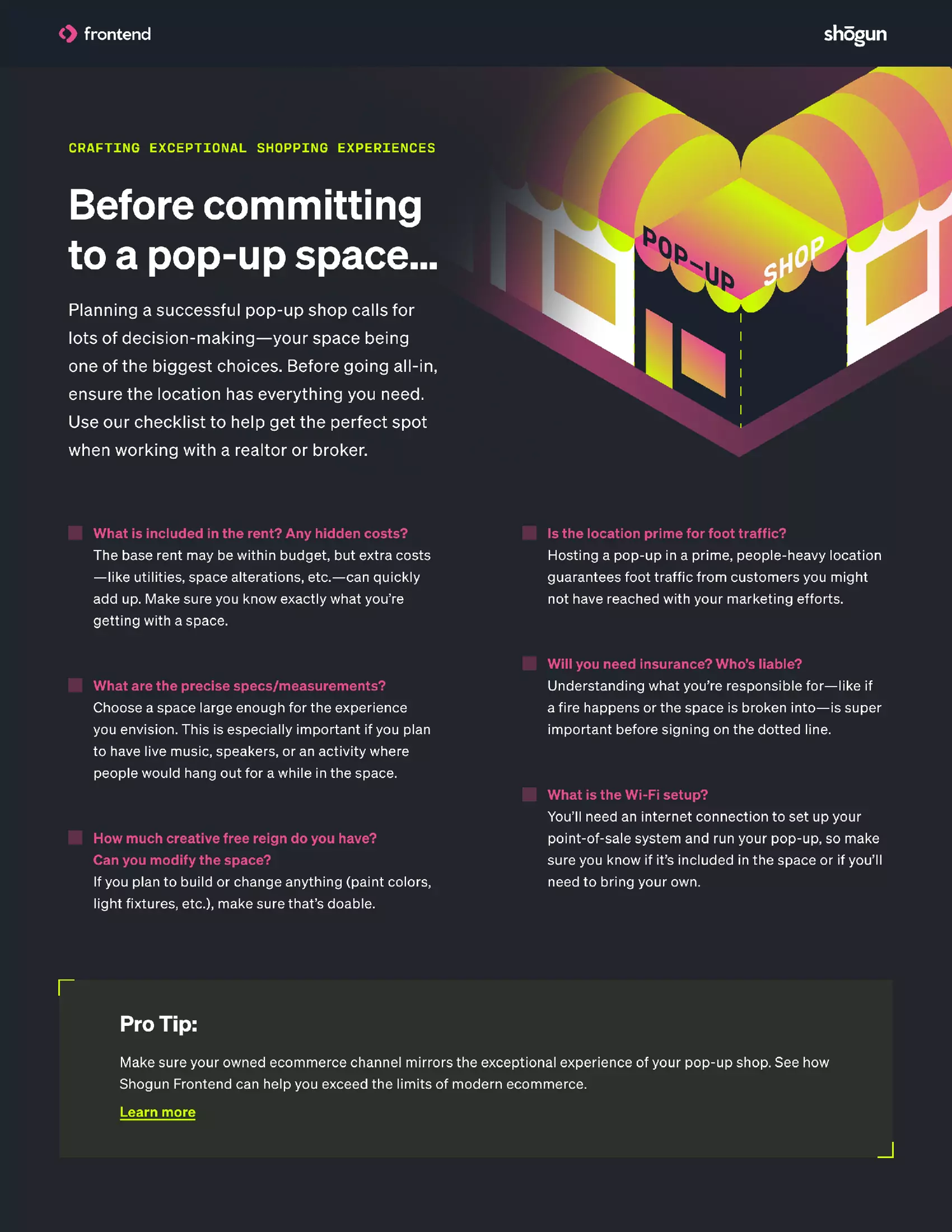
How much does it cost to run a pop-up shop?
Because pop-up shops are of varying sizes, shapes, and vibes, how much it costs will depend on the type of space you want and how long you want to rent it.
When thinking about your budget for your pop-up shop, consider these factors:
- Rent price
- Space size
- Staffing
- Set-up costs
- Marketing and advertising
- Utilities and wifi
- Insurance
- A POS system
Typically, brands can expect to spend anywhere from $1,500 to $10,000 to bring their pop-up shop to life. The more you want to add to the experience (e.g., art installations, live music, speakers, etc.) your cost will increase.
Figure out what’s most important to your brand and go from there. It’ll be easier to see what can get cut from production and what you consider to be a “must-have.”
Customers want to experience something unique at a pop-up shop—that’s one of their biggest draws.
Why not adopt the same experiential mindset to your marketing strategy?
Here are a few great ways to test this out for your brand:
Influencer partnerships
In addition to posting on your social media channels, collaborating with influencers, bloggers, and creatives to promote your pop-up is a great way to tap into audiences you might otherwise not access.
Reach out to the influencers who best align with your brand about becoming involved in your pop-up shop. Offer an exclusive discount code they can share with followers in addition to sending free products for them to test out ahead of time.
Creative alternatives
Scavenger hunts, secret locations, and special guests are great ways to spark curiosity and encourage customers to attend. One notable example of creative marketing comes from the Italian clothing brand, Diesel.
Diesel launched a pop-up stacked with “knock-off” versions of their clothes—fake logos and all— in NYC’s Chinatown. The pop-up was open for a few days until Diesel announced all items sold at that pop-up were authentic but at knock-off prices. Soon after, lines began to form outside the pop-up as customers tried to purchase the exclusive Diesel apparel. Talk about creating a buzz!
#cta-visual-pb#<cta-title>Design your store, your way. <cta-title>Create the exact page designs you want and save time building with features that give you more control. Learn more
While many brands turn to pop-up shops to create brand awareness and increase conversions, brands are redefining the pop-up experience. Here’s a look at some of our favorite examples of pop-up shops:
1. Jeni’s Splendid Ice Creams
Artisan ice cream maker, Jeni’s, is known to host pop-ups across major US cities.
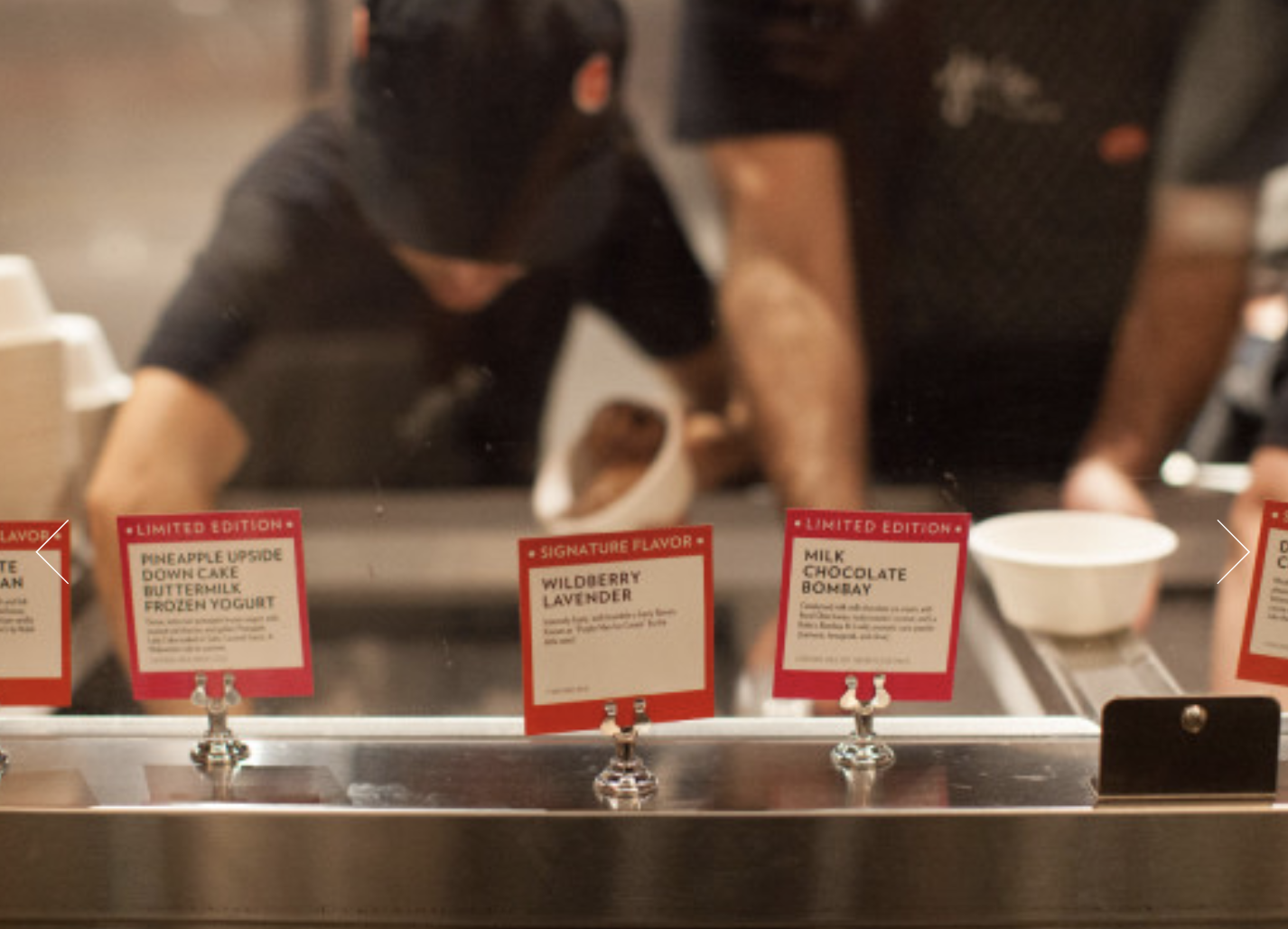
Their Gotham Market West pop-up in NYC offered exclusive flavors and created quite the buzz.
2. Poppy Barley
Premium leather goods brand, Poppy Barley, knows how to get customers excited about new product drops.
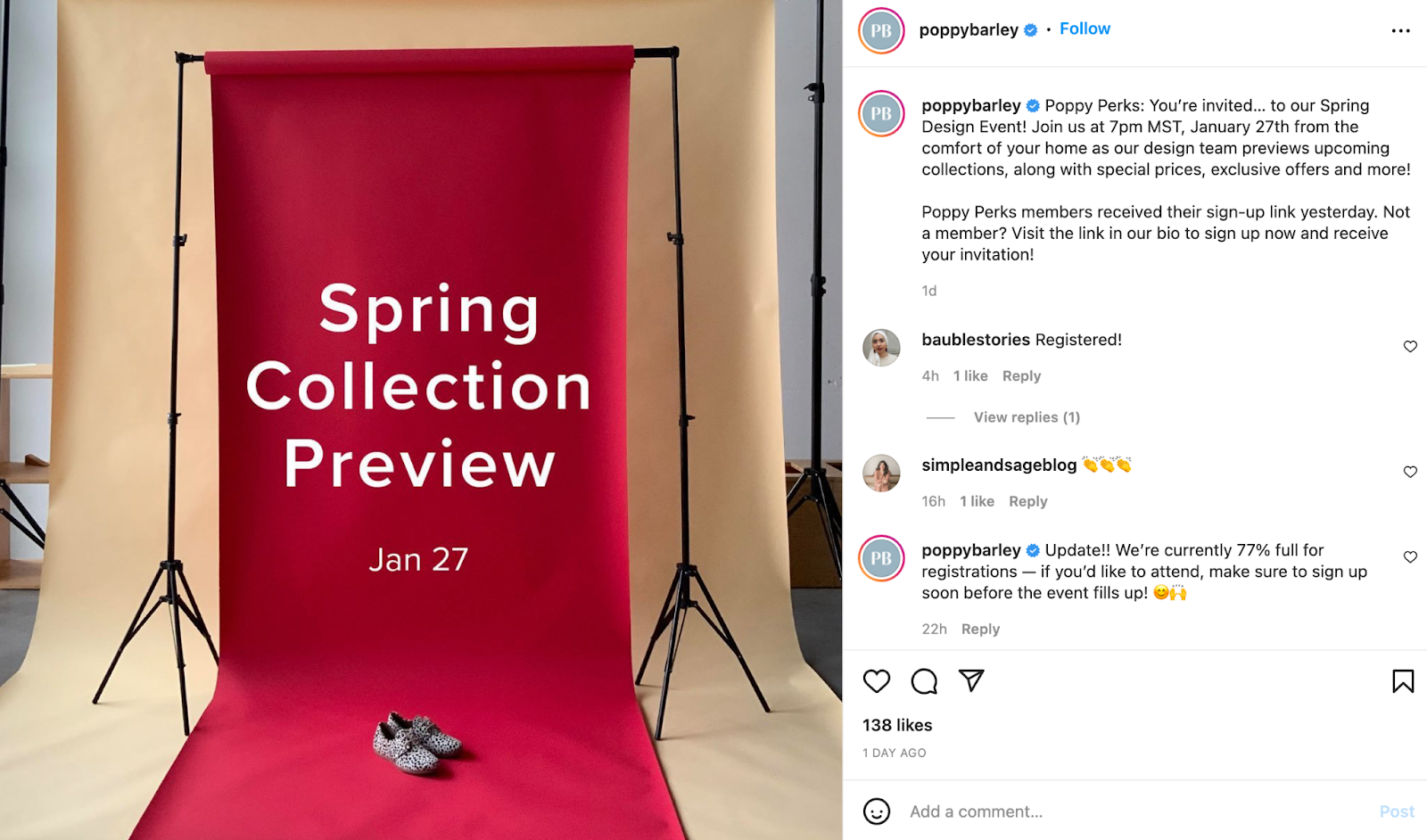
Even with in-person event restrictions in Canada due to COVID-19, Poppy Barley hosts virtual pop-up events featuring new collections. While the event is virtual, the brand is still putting a stamp of exclusivity on it—Poppy Perks members received sign-up links ahead of other customers, which incentivizes folks to sign up.
3. Pantone Café
This pop-up shop by Pantone is one of the coolest examples we’ve seen. Instead of a pop-up shop selling Pantone products—color chips, swatches, and more—they sold color-coded snacks and drinks.

Talk about a creative way to get people talking! For multi-channel brands: consider if you can pair up with a more traditionally artistic brand to bring flavor to your retail brand experience.
4. Bottega Veneta
A Bottega Veneta pop-up shop? Where? That’s right, the luxury fashion brand hosted an invisible pop-up shop in the center of a mall in Shanghai to kick off a new collection.
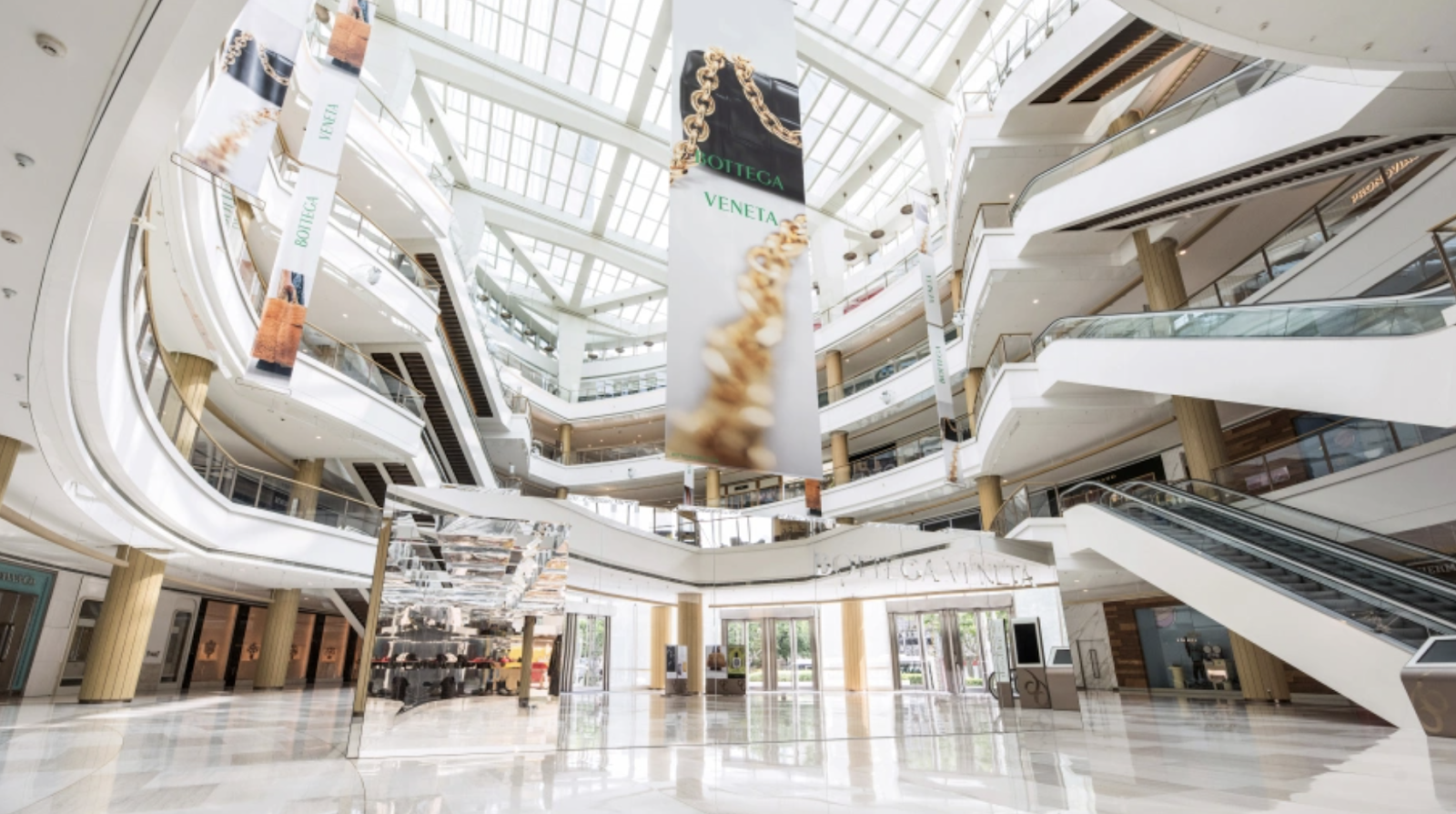
Dubbed “The Invisible Store,” this pop-up speaks to Bottega’s values of subtlety, discretion, joy, and sensuality, CEO Bartolomeo Rongone told WWD.
5. The Hundreds x West Coast Customs
The Hundreds, a community-based streetwear brand, partnered with custom auto repair shop, West Coast Customs to drop a new line of exclusive apparel.

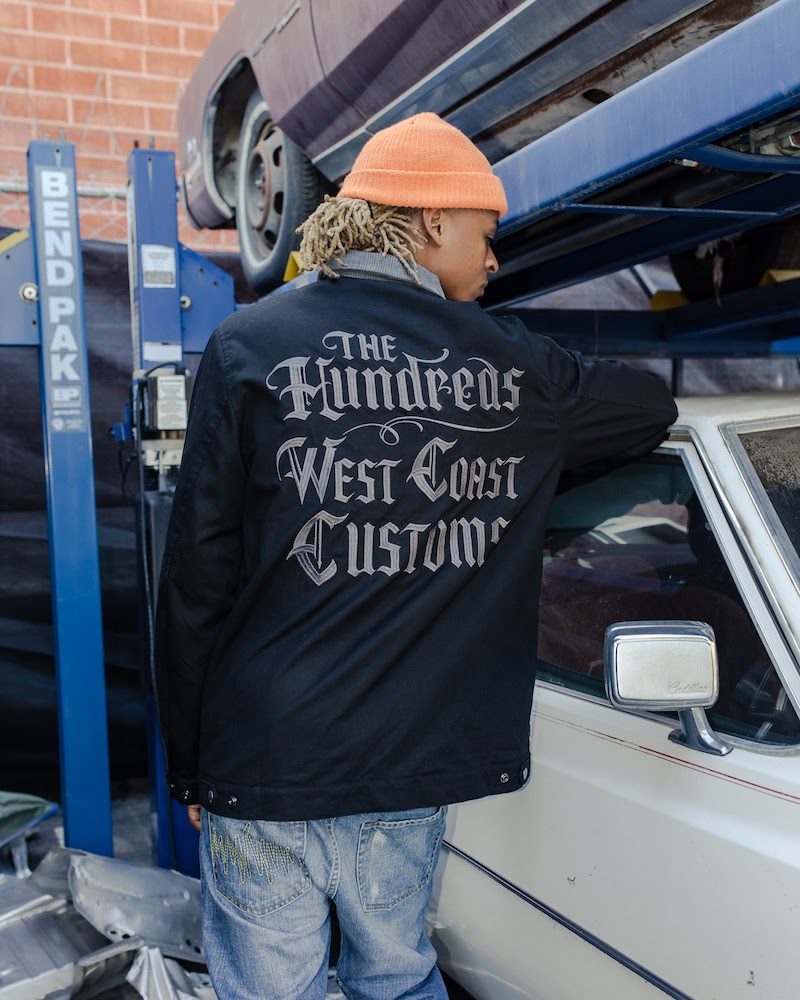
The drop was coupled with a pop-up event featuring live music, tattoo artists, and even a car show.
6. Glossier
Skincare and makeup brand, Glossier, opened a pop-up shop in London November 2019. It was so successful it stayed open for the rest of the year, making it Glossier’s most successful pop-up shop at the time.
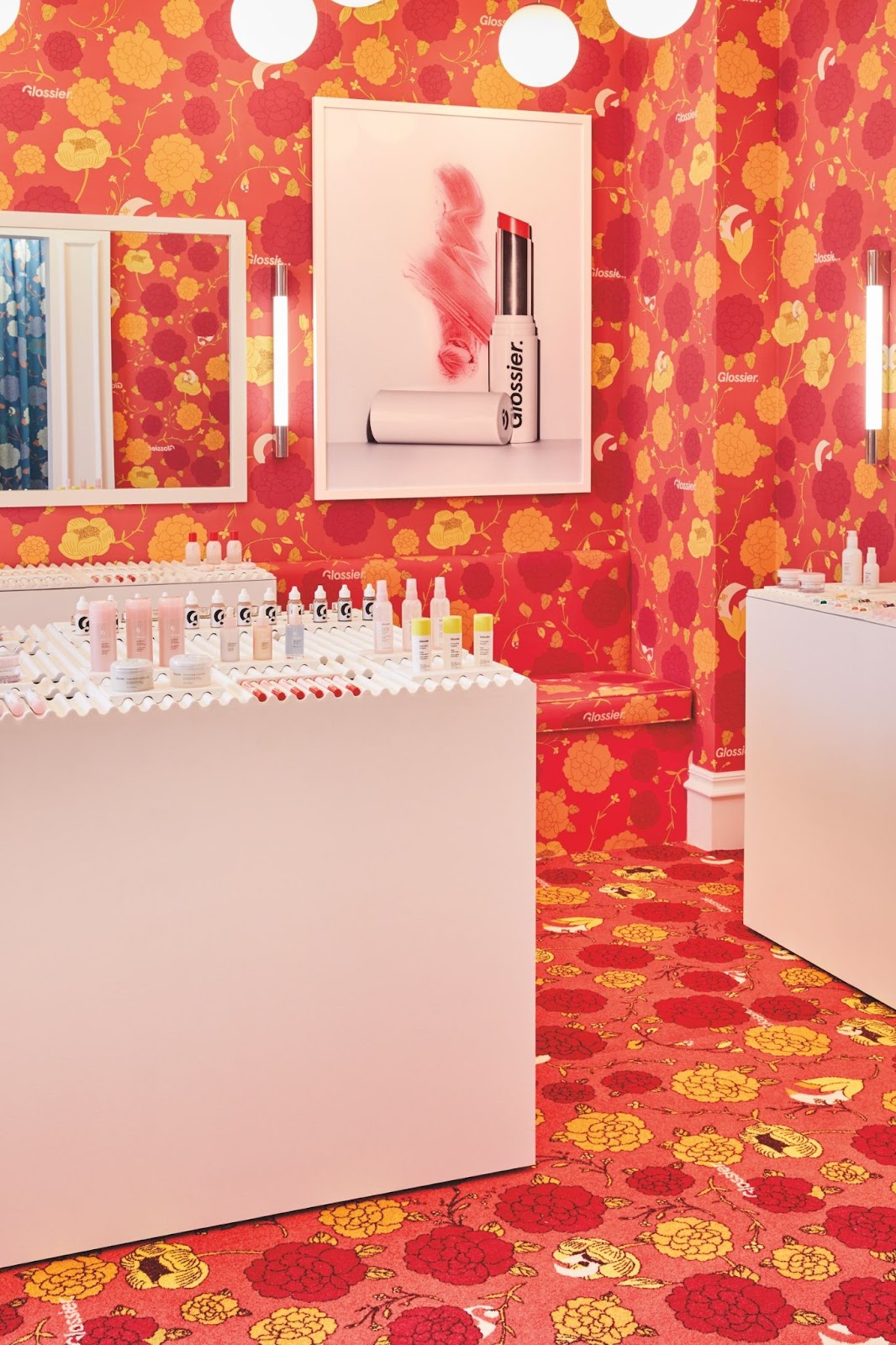
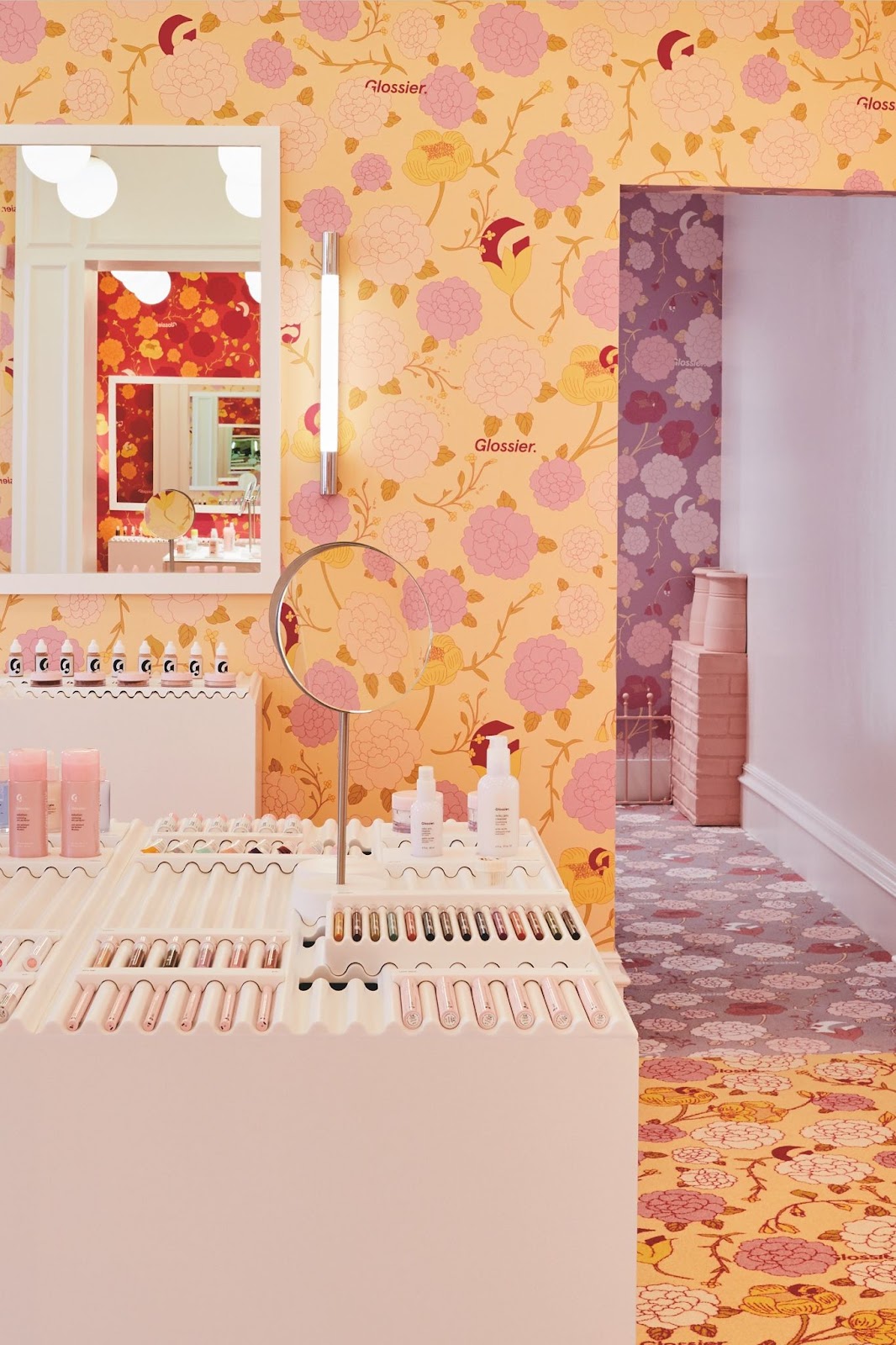
The pop-up featured rooms inspired by traditional British social clubs and featured makeup stands with mirrors facing one another, encouraging customers to chat and connect.
7. LEGO
LEGO paired up with Snapchat to create a digitally innovative customer experience.
But instead of selling LEGO sets, this pop-up featured a white room with a single snap code where customers could shop for LEGO-branded streetwear, known as LEGO Wear, in AR.
8. Barbie’s 60th Anniversary
In 2019, fashion doll Barbie, rang in her 60th anniversary in style. To celebrate, Barbie fans could take a tour through Barbie’s Dream House and marvel at all the career moves and her friends have made in the last six decades. It was an immersive experience for old and young Barbie fans alike!
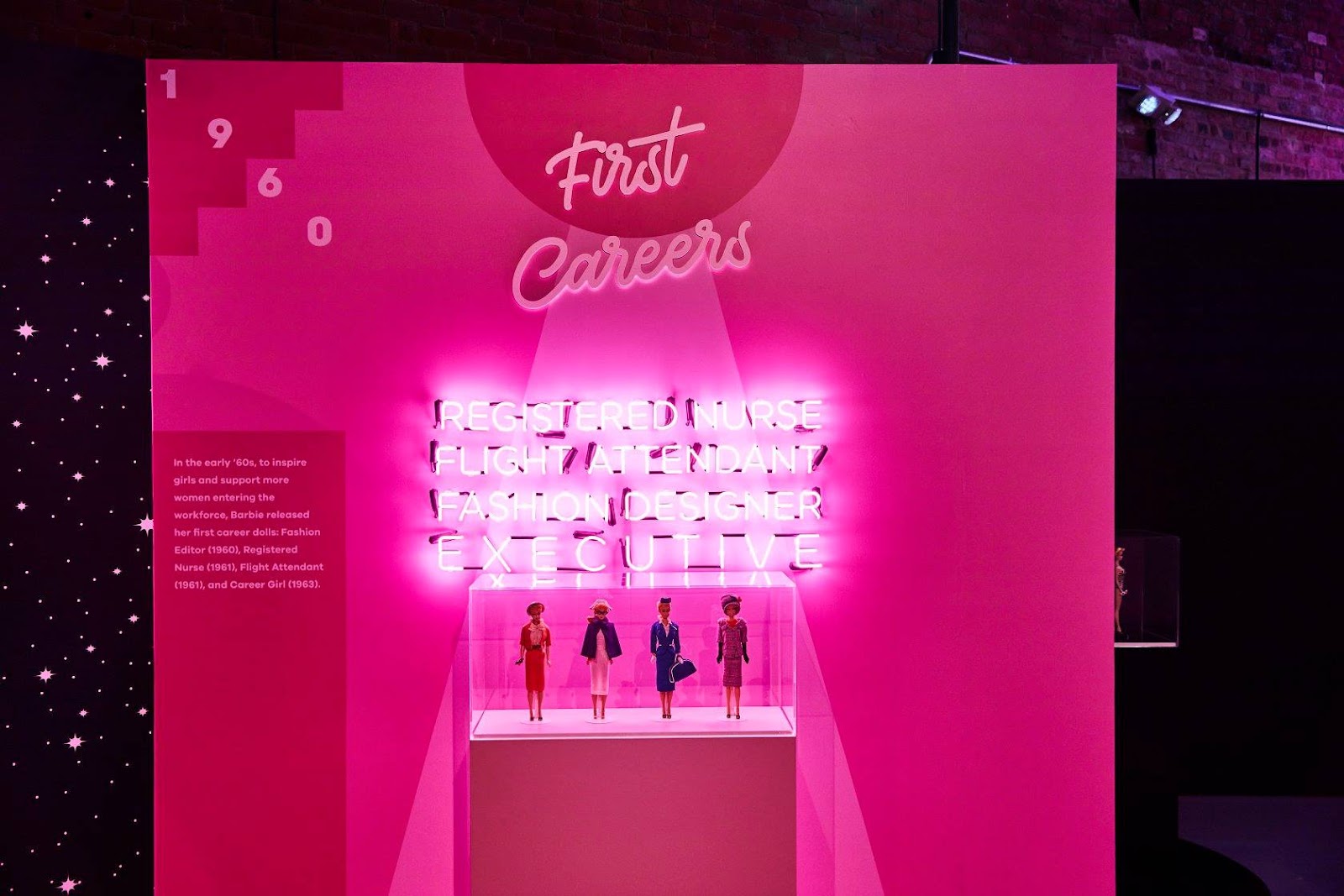
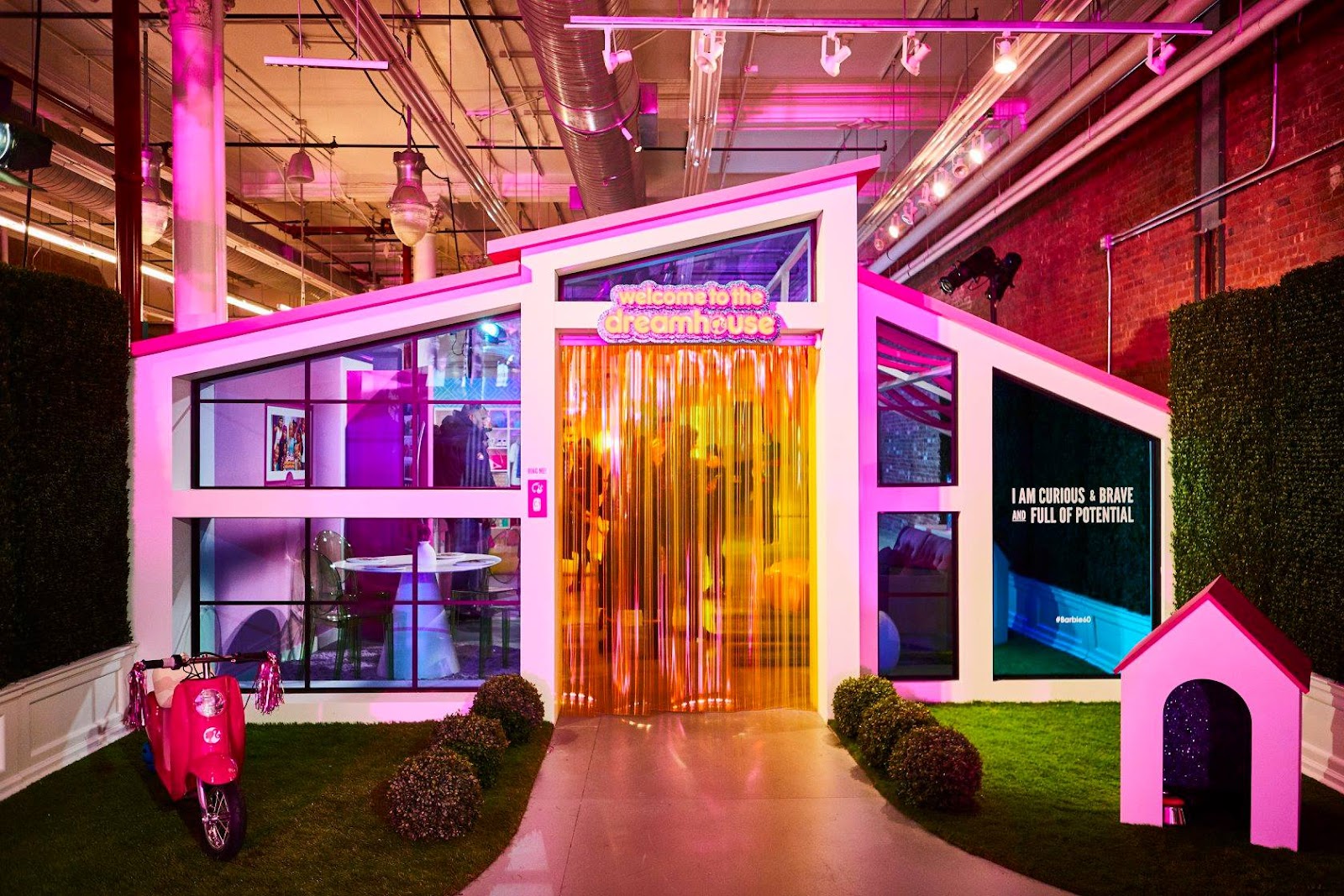
9. Nike
Ahead of Super Bowl 53 in 2019, Nike set to merge its digital and physical shopping experiences into one pop-up shop in Atlanta. Users of Nike’s SNKRS app could unlock pairs of exclusive shoes while at the pop-up.
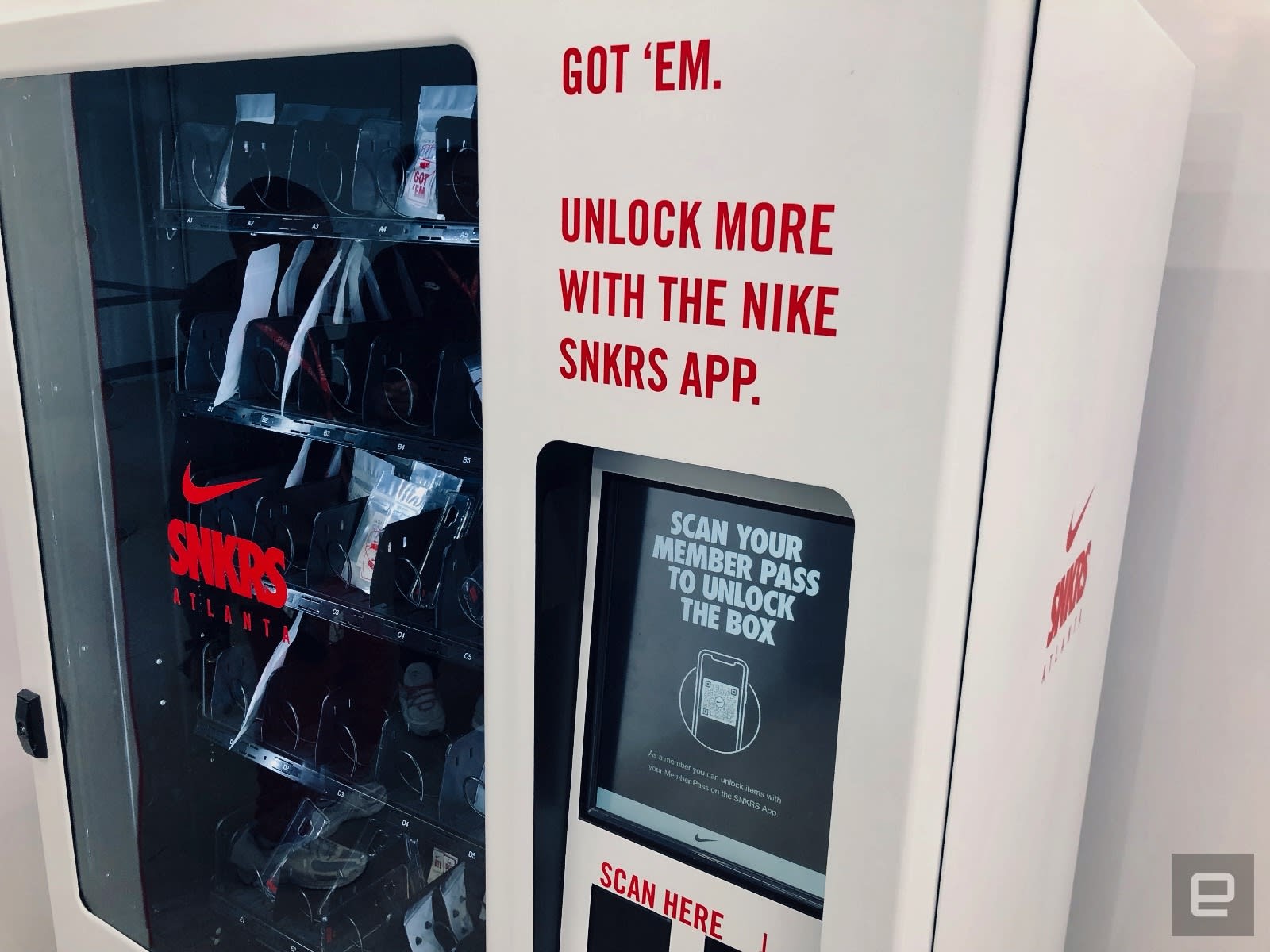
What’s more, Nike used geofencing to send push notifications to app users within a 25-mile radius of downtown Atlanta when new shoes were available to purchase. For sneakerheads, this was a dream event.
10. Dyson
Fans of Dyson’s sleek, powerful vacuums, fans, and hair tools alike can marvel (and test out) the household appliance brand’s diverse product offerings IRL.
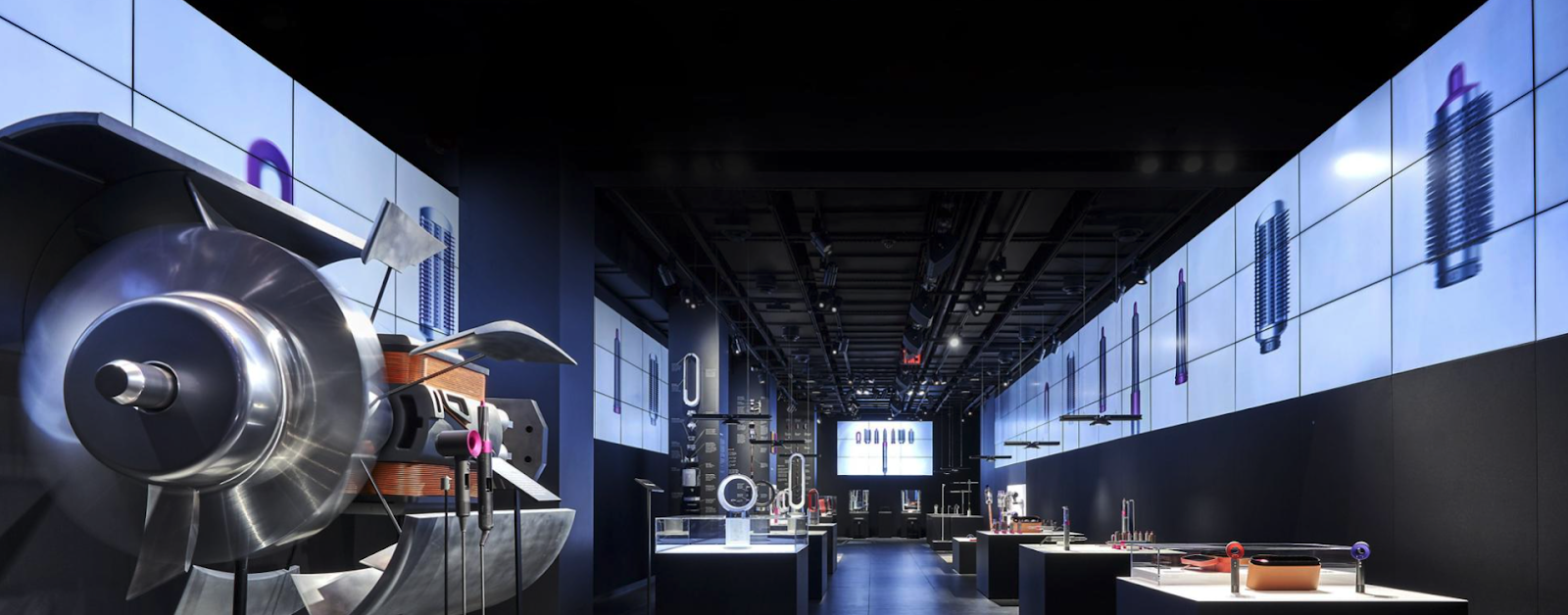
Dyson Demo Stores offer customers the chance to demo products in person (or virtually) and discover which is right for their needs.
Like digital campaigns, there isn’t one single metric to determine the success of a pop-up shop. A combination of metrics will help you understand how things went (and what could be different for next time).
Here are some of the most notable metrics to track:
- Order value: How much did customers spend while at your pop-up shop? Knowing this offers insight into the kinds of items customers gravitated towards.
- Product type: Product type, like order value, offers insight into what kinds of products were sold the most at your pop-up. This could help you determine what kinds of products to fill shelves with for future events and what to keep exclusively online.
- Sales by date: Knowing which days and hours brought in the most sales can inform future pop-up shop planning. For example, if the majority of your sales occurred on Saturday before noon, you could find ways to stretch that window even further—like hosting a giveaway during that time or hiring more staff.
- Sales by channel: A pop-up shop could be the first interaction a customer has with your brand, so they may not purchase right away. That’s why knowing sales by channel within the timeframe of your popup is so important—you gain insight into your customers’ journey and can optimize.
Pop-up shops can help your brand be exceptional IRL
These days, having a unified brand presence across channels—both digital and in-person—is crucial for brands to connect with customers and communicate their all-encompassing brand ethos.
Gaining control over your customer experience online allows you to create richer, more memorable ecommerce experiences. Make sure you craft exceptional online shopping to match= your in-person pop-up shop experience.
#cta-visual-pb#<cta-title>Design your store, your way.<cta-title>Create the exact page designs you want and save time building with features that give you more control. Learn more

Kaitlyn Ambrose
Kaitlyn works on all things content at Shogun. ⚡

